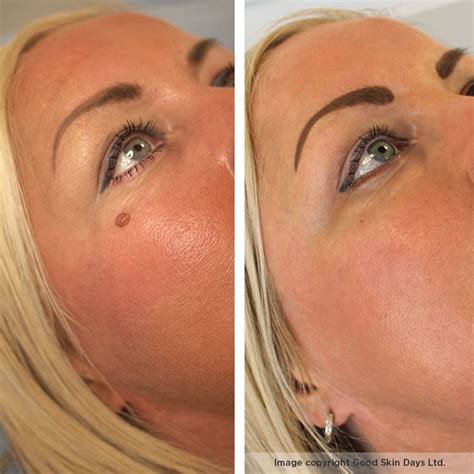Moles can be a stubborn skin issue for many, causing concern both for their appearance and potential health implications. The removal of moles is a common practice, both for cosmetic reasons and when there’s a suspicion of cancer. However, it’s essential to understand the different types of moles, the reasons for their removal, and the methods available for doing so.
Understanding Moles
Before delving into mole removal, it’s crucial to understand what moles are. Moles, also known as melanocytic nevi, are growths on the skin that occur when cells in the skin called melanocytes grow in a cluster. Most moles appear by the age of 20, although some may develop later in life. They can be flat or raised, and their color can range from pinkish to very dark, almost black. While most moles are harmless, in rare cases, they can develop into melanoma, a type of skin cancer.
Reasons for Mole Removal
There are several reasons why someone might choose to have a mole removed. These include:
- Cosmetic Reasons: Many people opt for mole removal because they find their moles unattractive or because the moles are located in areas that are easily seen, such as the face.
- Suspicion of Cancer: If a mole is suspected to be cancerous or pre-cancerous, removal is necessary for further examination and to prevent potential spread.
- Irritation: Moles can sometimes cause irritation, especially if they are constantly rubbed by clothing or if they are located in an area prone to friction.
Methods of Mole Removal
There are several methods for removing moles, and the choice often depends on the type of mole, its location, and its size. These methods include:
- Surgical Excision: This involves cutting out the mole and stitching the skin closed. It’s often used for moles that are suspected to be cancerous or for larger moles.
- Shave Removal: This method involves using a special tool to shave the mole off the surface of the skin. It’s more common for smaller moles that are not suspected to be cancerous.
- Laser Removal: Laser mole removal can be effective for flat moles. It works by breaking up the pigment of the mole with a laser.
- Freezing (Cryotherapy): This involves using liquid nitrogen to freeze the mole, causing it to fall off. It’s more commonly used for treating warts but can be applied to certain types of moles.
Pre-Removal Considerations
Before deciding on mole removal, it’s essential to consult with a dermatologist or healthcare provider. They can:
- Examine the Mole: To determine if it’s benign or if there’s a possibility of it being cancerous.
- Discuss Risks and Benefits: Each removal method has its risks, such as scarring, infection, and changes in skin color. It’s crucial to understand these before making a decision.
- Recommend the Best Method: Based on the size, location, and type of mole, as well as the individual’s health and skin type.
Post-Removal Care
After a mole has been removed, proper wound care is essential to prevent infection and promote healing. This typically involves keeping the area clean, applying antibiotic ointment, and covering the wound with a bandage. It’s also important to follow up with your healthcare provider to ensure the wound is healing properly and, in the case of a mole sent for biopsy, to discuss the results.
Prevention and Monitoring
While not all moles can be prevented, protecting the skin from the sun is crucial, as sun exposure can lead to new moles and increase the risk of skin cancer. This includes using sunscreen regularly, wearing protective clothing, and avoiding tanning beds. It’s also important to monitor your skin for new moles or changes in existing moles, using the ABCDE rule as a guideline:
- Asymmetry: One half of the mole doesn’t match the other half.
- Border: The edges are irregular, ragged, or blurred.
- Color: The color is not uniform and may include shades of brown, black, and tan.
- Diameter: The mole is larger than 6mm.
- Evolving: The mole is changing in size, shape, or color.
Conclusion
Mole removal can be a straightforward process when done for the right reasons and by the right professionals. Whether the motivation is cosmetic or due to health concerns, understanding the process, the methods available, and the importance of post-removal care can make a significant difference in the outcome. Always consult with a healthcare professional before making any decisions about mole removal.
What are the most common reasons for mole removal?
+The most common reasons for mole removal include cosmetic reasons, suspicion of cancer, and irritation. Cosmetic reasons often pertain to the mole's appearance or its location on the body. Suspicion of cancer is a serious concern that requires immediate medical attention, and irritation can be due to the mole's location or its characteristics.
How do I know if I should have a mole removed?
+Deciding whether to have a mole removed should be done under the guidance of a healthcare provider, such as a dermatologist. They can assess the mole for any signs of cancer, discuss the potential risks and benefits of removal, and recommend the best course of action based on the mole's characteristics and your individual health and skin type.
What are the risks associated with mole removal?
+Risks associated with mole removal can include scarring, infection, and changes in skin color. The level of risk can depend on the removal method, the location and size of the mole, and the individual's overall health. Proper wound care and follow-up with a healthcare provider can minimize these risks.
How can I prevent new moles from forming?
+While not all moles can be prevented, protecting your skin from the sun is a crucial step in preventing new moles and reducing the risk of skin cancer. This includes using sunscreen regularly, wearing protective clothing, avoiding tanning beds, and monitoring your skin for changes.
What should I look for when monitoring my moles?
+When monitoring your moles, look for the ABCDE signs of melanoma: Asymmetry, Border, Color, Diameter, and Evolving. If you notice any of these changes or have concerns about a mole, consult with a healthcare provider.
By combining accurate information, expert insights, and user-friendly guidance, individuals can make informed decisions about mole removal, ensuring their skin health and aesthetic concerns are addressed with the highest level of care and professionalism.



